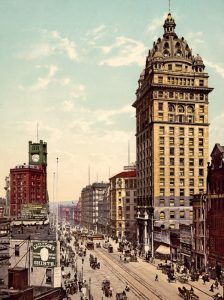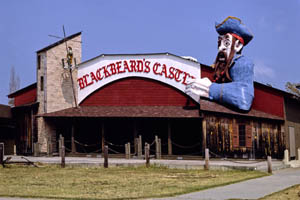
When the beautiful Pennsylvania Station began to be demolished in 1963, it caused international outrage. Photo by Cervin Robinson, 1962.
Since America began to be populated by Europeans, numerous buildings and important sites were established. In these early years, the colonists were more interested in survival and, later, in forming their nation to be too involved in preserving historic buildings. However, many did survive, including those in the Independence National Historical Park in Philadelphia, Pennsylvania, and in the earliest Spanish settlements of St. Augustine, Florida, and Santa Fe, New Mexico. Spanish missions across the Southwest and California still stand, as well as 17th-century buildings in New England.
However, several important and interesting sites have been lost over the years due to cities’ urbanization and others’ decay. The years between 1880 and 1920 changed American cities as they went through a period of industrial progress, and to make room for more substantial buildings, many old ones were torn down. After World War II, many structures that represented first-of-a-kind technical achievements just years before became outdated and were demolished.
Over the following decades, more buildings were torn down as cities grew. Many of these were demolished due to neglect, others due to health and safety reasons, some due to maintenance and upgrade costs, and more to expanding and redeveloping cities and roads.
But still, many historic buildings remained. In 1949, the US National Trust for Historic Preservation, a privately funded non-profit organization, began, and 28 states joined. In New York City, the destruction of Pennsylvania Station in 1964 shocked many nationwide into supporting preservation. Soon, new laws began to protect buildings and entire districts. In 1966, the National Register of Historic Places was established to protect historic properties. However, this designation doesn’t prevent the demolition of a historic property if the site is a threat to society due to fire damage, asbestos, and/or neglect.
More recently, there has been a surge in interest in revitalizing historic downtowns that suffered in the last several decades due to the expansion of suburbs. Today, many people respond to those revitalizations by revisiting downtown spaces for entertainment and buying and renting these character-rich spaces.
Our Vanished Sites Photo Gallery includes many historic landmarks that have been lost over the years and other popular destinations for visitors and travelers in the last decades. These include many sites on old Route 66 and other destinations that display former lodging facilities, diners, and roadside attractions.
©Kathy Alexander/Legends of America, updated February 2024
Brigantine Castle, NJ – Lost to the Ghosts
Buckroe Beach Resort, Hampton, VA
Call Building, San Francisco, CA
Fox Theatre – Lost in Seattle, WA
Grand Riviera Theatre, Detroit, MI
Jolly Cholly Funland, North Attleboro, MA
Original Pennsylvania Station, New York City
Palace Amusements, Asbury Park, NJ

Berwyn, Illinois Car Spindle on Route 66. It was created in 1989 and demolished in 2008. Photo by Carol Highsmith, 2007.

The ornate Call Building in San Francisco was built in 1898. But, over the years, its
decorative friezes and arched windows were replaced in favor of an unadorned concrete tower.
©Kathy Alexander/Legends of America, updated February 2024.
Also See:

Blackbeard’s Castle was once part of the amusement park at Buckroe Beach in Hampton, Virginia. Photo by John Margolies, 1985.
Ghost Towns & Mining Camps Across America
Scenic Byways & Historic Trails
Sources:
Cinema Treasures
Gizmodo.com
Hometown Demotion Contractors
National Park Service
Saving Places
